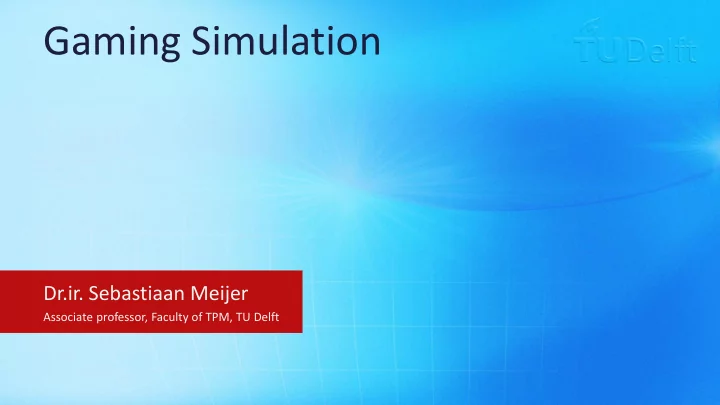

Gaming Simulation Dr.ir. Sebastiaan Meijer Associate professor, Faculty of TPM, TU Delft
Overview Systems thinking and its actors Multi-actor, multi method What is Gaming Simulation Example: ProRail Example: SprintCity Future trends
System thinking and its actors Socio-technical systems Choices in governance, management and operations Freedom of choice for travellers Complex adaptive systems Companies, operators = Adaptive agents Intertwining & complexity = Dynamic relations Performance = Emergent behaviour Research & Design tools: often mono-disciplinary & disjoint
Diagrams Complex Adaptive System Actor 4 Actor 2 Actor 3 Actor 1 Social Network Actor 6 Sociotechnical Network Human 1 Human 2 Human 3 SociotechSoc Technical Component 1 Component 2 Component 3 Component 4 Component 5 Network Actor 5
Multi-actor, multi-method! Engineers Managers Politicians Design process Control cycles (yearly, Fluid coalition forming (V-model, step-based periodically) (policy arenas) approach) Cognitive uncertainty Performance (indicator) Scope (boundary) uncertainty uncertainty ‘Best’ solution, best ‘Accepted’ solution, ‘Negotiated’ solution, available knowledge reasonable knowledge disputed knowledge Mixed tools: project and Soft tools: participation, Hard tools: simulation, process management image, spinning models, calculations
What is Gaming Simulation? A gaming simulation session: mimics the behaviour of a real-world system Uses real people as decision makers Combines with (computerized) simulation models A broad range of simulations in which the role of a human decision maker is enacted by a real human participant instead of a computer. Technology is not essential, but driven by the goals of the gaming simulation.
History of gaming simulation War games (19th and 20th century) Policy making: testing complex systems Richard D. Duke, 1974 Gibbs, 1974 Related to SSM (Checkland and Scholes) Shubik. The uses and methods of gaming. Elsevier New York, 1975. Computer gaming: since 1980’s Serious applications : end of ’90’s Now: integration of the two streams
Analytical science Organization Participants Org. change evaluation Design science Roles Qualitative Learning eval. Gaming Rules Real Data simulation Session world Objectives design Constraints Quantitative Load Data Situation Participants with exp. Changed Organization
Example: ProRail ProRail is the Dutch railway infrastructure manager Gaming simulation to reduce uncertainty in decision making on operational future Four-year research contract, working closely on some key projects. Computer-based & analog games Depends on phase in decision making
Gaming in railway traffic control Traditional innovation in railway operations is top- down Testing in computer simulations Then push to operations? But will it work in practice? Current robustness and resilience is already under pressure Engineering has many assumptions about the operations. The difference between theory and practice exists only in practice Talking with operations doesn’t help: do it with them! Reason is found in implicit, but very effective, mental models
The challenge 100% extra trains 2020 50% in 2012 regional First: major corridors “ Untimetabled traffic” Like a metro system All within 10% of the budget required in the ‘old’ way
Project: ETMET 2010 Real-world test: Sept 2010 Amsterdam – Eindhoven 6 – 6 – 2 pattern Preparations Spring 2010 Question: how to handle a major disruption? Two types of handling predefined by staff experts Will this work out with the operation?
ETMET Game
Models of reality Trains: scour sponges Combination of wagons of certain type Each with associated capacity One train driver, one head of cabins (flags with real numbers) A route-setting (real map) A time-table (card, real numbers) Real data sheets Video distribution for computer systems Portophone for RailPhone / intercom
Model types ‘Iconic’ representation: relevant elements ‘As -if- real’ representation: crucial elements ‘Playful’ representation: non -relevant elements
Example: SprintCity Relation urban development & transport system Deltametropool agency Urban inner city areas connected through metro-like trains. Transport system constraints on urban planning Computer-based game For domain specialists Multi actor Fictitious or real roles
Example: SprintCity
Floor Space Index FSI netto wijk < 0,6 0,6 - 1,2 1,2 - 1,7 1,7 - 2,2 > 2,2 Type leefmilieu suburbaan - jaren 70-80 generiek - jaren 70-80 32 subtypes suburbaan - recent generiek - recent kern - historisch ruraal - historisch lint werkstad - industrie winkelkern recent ruraal - 19de eeuws werkstad - kantoren grondgebonden compact - 19de eeuws ruraal - begin 20e eeuw werkstad - grootsch. havengebied compact - begin 20e eeuw ruraal - naoorlogs publiek - educatie compact - naoorlogs ruraal - jaren 70-80 publiek - ziekenhuis compact - jaren 70-80 ruraal - recent publiek - sport compact - recent modern - naoorlogs publiek - overheid suburbaan - 19de eeuws modern - jaren 70-80 publiek - overig suburbaan - begin 20e eeuw modern - recent suburbaan - naoorlogs generiek - naoorlogs
Model-based evaluation Public transport mobility versus urban profile Constraints on money, other stations, transport capacity and environmental factors Equations behind purely qualitative interface Learning outcomes: complexity & dependency in urban development. Need for collaboration with transport
Model-based evaluation
Future Vision Gaming, Simulation and Big Data will integrate Multi-scale modelling, and data-driven gaming Visualisation and Interactivity Computing Technology becomes useful for gaming Decision-making evidence-based Joint fact finding Integration of operations in strategic decisions Inductive and deductive cycles through gaming, participatory methods, etc.
Gaming Simulation Visualisation & Analogue Platforms Interactivity Distributed Cognitive Big Data Task analysis Simulation
Gaming Simulation Visualisation & Analogue Platforms Interactivity Distributed Cognitive Big Data Task analysis Simulation
Gaming Simulation Visualisation & Analogue Platforms Interactivity Distributed Cognitive Big Data Task analysis Simulation
Conclusions Designing infrastructures is a multi-actor problem This requires methods that involve people. Gaming simulation
Thanks for your attention! Please post any questions on our discussion forum
Recommend
More recommend